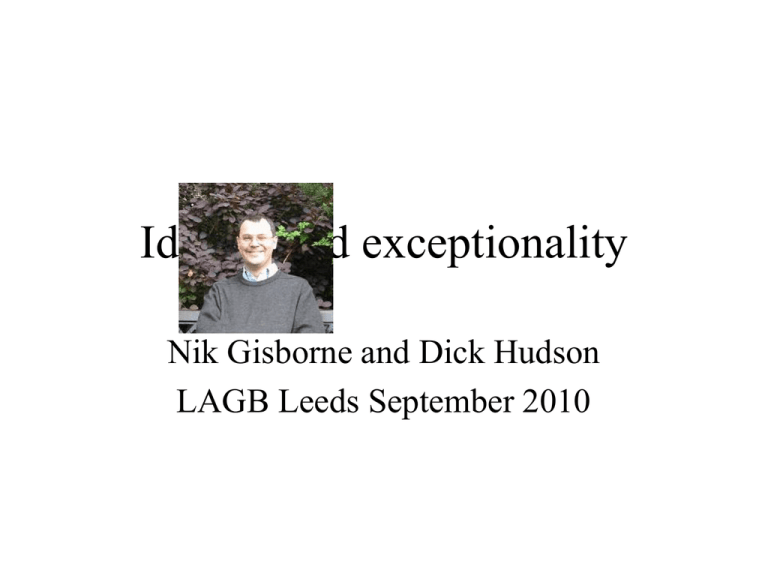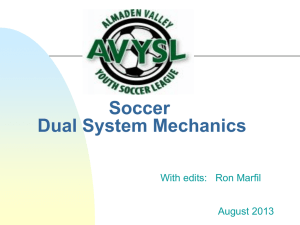Idioms and irregularity
advertisement

Idioms and exceptionality Nik Gisborne and Dick Hudson LAGB Leeds September 2010 Idioms are exceptional E.g. kick the bucket • exception to general compositionality: – it means ‘die’, not ‘kick the bucket’ • exception to general syntax: – no passive: *The bucket was kicked. – no tough movement: *The bucket was hard to kick – etc. Our questions • Why are such exceptions possible? – Does default inheritance help? • How are idioms stored in relation to their constituent lexemes? – Do the ‘sub-lexemes’ of Word Grammar help? • How are idioms organized syntactically? – Does dependency structure help? – Do we need phrases? Kinds of idiom Nunberg, Sag and Wasow 1994 distinguish: • ‘idiomatic phrases’(IdP) – e.g. kick the bucket – rigid syntax • ‘idiomatically combining expressions’ (IdCE) – e.g. bury the hatchet – some syntactic freedom • e.g. The hatchet was buried. More recent research in linguistics Nunberg at al’s contrast has been explored: • George Horn (2003): IdCEs are syntactically regular if the parts have regular theta roles. • Espinal & Mateu (2010): IdP vs IdCE is too rigid, e.g. laugh ones head off is part IdP, part IdCE. • Jackendoff (1997, 2008): accepts IdP vs IdCE. – Influential player. – Suggests a formal analysis. IdP or IdCE? • Is it likely that there are just two kinds of idiom? • Maybe there are degrees of opacity? – most opaque, e.g. kick the bucket – less opaque, e.g. bury the hatchet – least opaque, e.g. laugh ones head off • But how to measure opacity? – Does a network analysis help? Jackendoff: an IdP Doesn’t contribute at all to meaning. NB special role of head word! Jackendoff: An IdCE NB This is the only link between bury and the hatchet. Jackendoff’s analysis • IdP: totally rigid syntax – but: kicked the proverbial bucket • IdCE: totally free syntactic order – but: *They found the hatchet then buried it. – and excludes: buried the proverbial hatchet • IdCE: requires meaning:syntax = 1:1 – e.g. bury (‘reconcile’) the hatchet (‘a disagreement’) ‘Metaphorical semantic composition’ Metaphorical semantic composition • Isn’t sufficient for IdCE – raise (‘cause’) hell (‘disturbance’) isn’t an IdCE (Postal). • Isn’t necessary for IdCE His example! – let (‘reveal’) the cat (‘the secret’) out of the bag (??) • Isn’t necessary for literal meaning – do (‘cartwheel’) a cartwheel (‘cartwheel’) Research in psycholinguistics (1) • How does activation affect idioms? • How are idioms represented? – NOT as single words – But as phrases with a single entry • ‘The hybrid theory’ – Cutting and Bock (1997) – Superlemma theory (Sprenger et al 2006) Cutting and Bock (1997) Syntax is independent of words. Superlemmas Shows syntactic relations among parts. (But how?) NB model of activation, not structure. Research in psycholinguistics (2) • We access conceptual metaphors in idioms. – e.g. ‘anger is heat’ for blow one’s stack , but not jump down someone’s throat – Gibbs, Bogdanovich, Sykes and Barr (1998) • We process idiom syntax normally. – Peterson, Burgess, Dell and Eberhard (2001) • Literal word meanings become active during idiom production. – Sprenger, Levelt and Kempen (2006). To summarise, … • • • • Idioms have a single entry in memory. They contain ordinary lexemes. They involve ordinary metaphor. They have ordinary syntax. – But abnormal linkage to meaning – So syntax may be abnormally limited. Word Grammar 1984 1990 2007 2010 Part 1: How the mind works Part 2: How language works Part 3: How English works 2010 What Word Grammar offers • Default inheritance – allows exceptions • Sub-lexemes – allows partial differences within a lexeme • Dependency structure – allows words to relate directly • Network structure – explains spreading activation and relatedness For example: tall man height tall man > 1.75m referent height > typical height sense TALL 1.75m man sense ‘isa’ MAN stored type/lexeme dependent tall man token sense Default inheritance allows exceptions I.e. instances may have exceptional properties • e.g. tall overrides the default height. • Typically, a dependent enriches the head’s sense. – and may override default properties. – Any property can be overridden. • e.g. fake diamonds just look like diamonds So exceptionality ranges … • from zero – kick a ball [cf morphology: walked] • through partial – kick up a fuss [cf vowel-change: ran] • to total – kick the bucket [cf suppletion: went] Theoretical point • Default inheritance is different from unification. – Unification is blocked by conflict. • But default inheritance is widely accepted in AI models of cognition. • And it explains the prototype effects found by psychologists. Sub-lexemes • Lexemes are in a conceptual taxonomy: – e.g. TAKE isa full verb isa verb isa word • Each word token isa some lexeme. • So ‘sub-lexeme isa lexeme’ is permitted – e.g. TAKE/off isa TAKE isa verb … – like TAKE: TAKE/off inflects to took – unlike TAKE: TAKE/off is intransitive and … Sub-lexemes in idioms • KICK/bucket isa KICK • Syntax: – like KICK: it needs an object – unlike KICK: this must be THE/bucket • whose complement must be BUCKET/the • Semantics: – unlike KICK, its sense is ‘die’. pace Jackendoff … who rejects this kind of analysis: • 1997: – “a notational variant of listing a lexical VP” – “clumsy” … “collapses under its own weight” • 2008: – “no non-theory-internal reason to concentrate all the meaning in one morpheme” • but his own analysis locates meaning on head! Jackendoff: an IdP NB special role of head word! NB ‘die’ is separated from ‘kick’ by many links. NB direct link from ‘create a disturbance’ to ‘kick’ Two idioms in Word Grammar kick die sense sense KICK create dust sense create a disturbance c KICK/up • o c NB link from ‘fuss’ to ‘disturbance’ (not o KICK/bucket • • shown) KICK/fuss THE BUCKET UP sense c • • A/fuss FUSS/a IdPs and IdCEs in WG • • • IdPs and IdCEs use ordinary syntax. Their head words have exceptional senses. The network shows how close the idiomatic sense is to the literal sense. – • So there’s no need for any other IdP/IdCE contrast. We speakers can vary the syntax as we want. – But there’s no point in varying it if the parts are unrelated to the idiomatic meaning. Conclusion • The IdP/IdCE contrast has no theoretical status. • The range of possibilities found is as expected given: – – – – default inheritance sub-lexemes for syntactic and semantic detail dependents as semantic modifiers network structure Thank you • This slide show can be found at www.phon.ucl.ac.uk/home/dick/talks.htm







